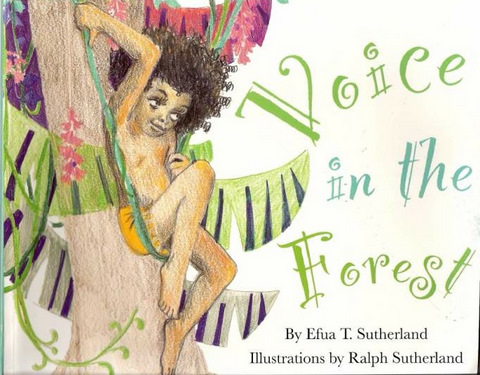(I use the Mummy, read… series to highlight books that my preschooler is currently enjoying)

The enthralling action in Voice in the Forest (1983) takes place in an unnamed farming village in Ghana. Bempong leaves home early one Friday to retrieve a hoe that he left in his farm, deep in the surrounding forest. It is important that he returns to the village before sunrise because:
“Friday is the day on which the Goddess of Earth wants her rest. Everybody in the village believed that. So, work on the farmlands was not allowed on the day.”
He comes across a pretty, but disheveled, little girl. She does not respond to any of his questions regarding her identity. So he decides to take her to his home, get her fed and cleaned up. Everyone likes the girl when they see her. A curious figure arrives, stares at the child and leaves. He is Afrum, Bempong’s son. He is nicknamed ‘the Fool’ because he talks to animals. Sometimes, people don’t understand what he says.
To clean the child up, Bempong, with the village chief looking on, trims the child’s hair. After, the child speaks for the first time:
“GIVE ME BACK MY HAIR!” she screamed”
What a dramatic transformation! Gone is the charm as the child rages at Bempong. The villagers are horrified as it dawns on them that the child is a “Samanta child – a wood nymph, a creature of strange magical powers”. They cannot appease her and she, in turn, terrorizes the village from sunup to sundown. The village runs out of food as the farmers are too scared to return to their farms. The chief is besieged by the villagers as they begged to be saved from the tyranny of the Samanta child. But what can the chief do, what powers does he have against the nymph? One Friday, Afrum ‘the Fool’ returns to the village. Curiously, he is not scared of the girl. He takes her to his cottage, which includes a play area, with a beautiful sand-carpet covered with “patterns of animals, birds and leafy boughs”. The Samanta child is excited and quickly starts playing in the sand. Unfortunately, she grows bored and again demands the return of her locks. But Afrum says:
“Little Samanta, I promised you would have your hair back. And have it you shall. But before we settle that little problem, please be good enough to give me back my sand just as it was before. You must admit that’s only fair…JUST WHERE IT WAS BEFORE.”
Of course, she is cannot fix the sand. She gets frustrated, tells Bempong that he can keep the hair and runs back into the forest. Thus the villagers are saved. They resettle by Afrum’s cottage and name the new village Samantaase. The people choose Afrum as their new chief. The story ends with:
“To this very day, Friday is a sacred day on which nobody is allowed to farm. And to this very day, nobody is allowed to call a child a fool.”
Voice in the Forest draws upon the traditional fairy tales and folktales of Ghana. Unlike most traditional tales which seek to explain one thing, this story explains several things and practices; the mandatory rest day for farmers, the founding of a village and why calling children bad names is wrong. It’s ambitious. And yet it captures and holds a child’s attention so completely. The look on my son’s face when the pretty child transformed into the Samanta horror was priceless. I can see him enjoying this story for many years. There are subtle hints of the girl’s nature and of Afrum’s gift that a 5 year-old cannot see but which an older child will pick up. Afrum’s poetic yet playful utterances are delightful. The illustrations, by Ralph Sutherland, are just stunning. Stunning. Voice in the Forest is a fantastic story.
The author, Efua Sutherland (1924-1996), was a Ghanaian playwright and dramatist.
(This edition of the Voice in the Forest was published in 2006 by Afram Publications (Ghana) Limited. It is available in bookshops in Ghana. There is a kindle edition for sale at Amazon.com)
Lovely post. I can imagine my daughters enjoying this, even though they older.
LikeLike
Thanks, Sarah. The language is perfect for old children as well. All the best.
LikeLike
I am starting a new project on children’s literature so would be adding this. Thanks for your recommendation.
LikeLike
I have seen your project . It’s great and good luck with it. All the best.
LikeLike
This sounds like such a cute book. I am going to add it to my watch list, I see a copy is available used in the US as well. Thanks for the review!
LikeLike
And there is a version for Kindle. But I think children’s books work best in print.
LikeLike
Yes and plus, I don’t really want to buy a Kindle for a baby 🙂
LikeLike
Kinna, I am sure my last two tykes would love this book. And to make sure that they enjoy it thoroughly, I will do the reading myself. Thanks. Yeah, yeah, the headaches are ceaseless!!
LikeLike
Your two tykes would. Be sure to get the recording as well. This is a book that I enjoy reading to Kobby. Which is essential when I’m asked to read it for the 200th time! All the best.
LikeLike
I would be looking for this book to read to Nana Kwadwo. Thanks Kinna.
LikeLike
Yay! It’s a great story and the language is poetic and divine!
LikeLike